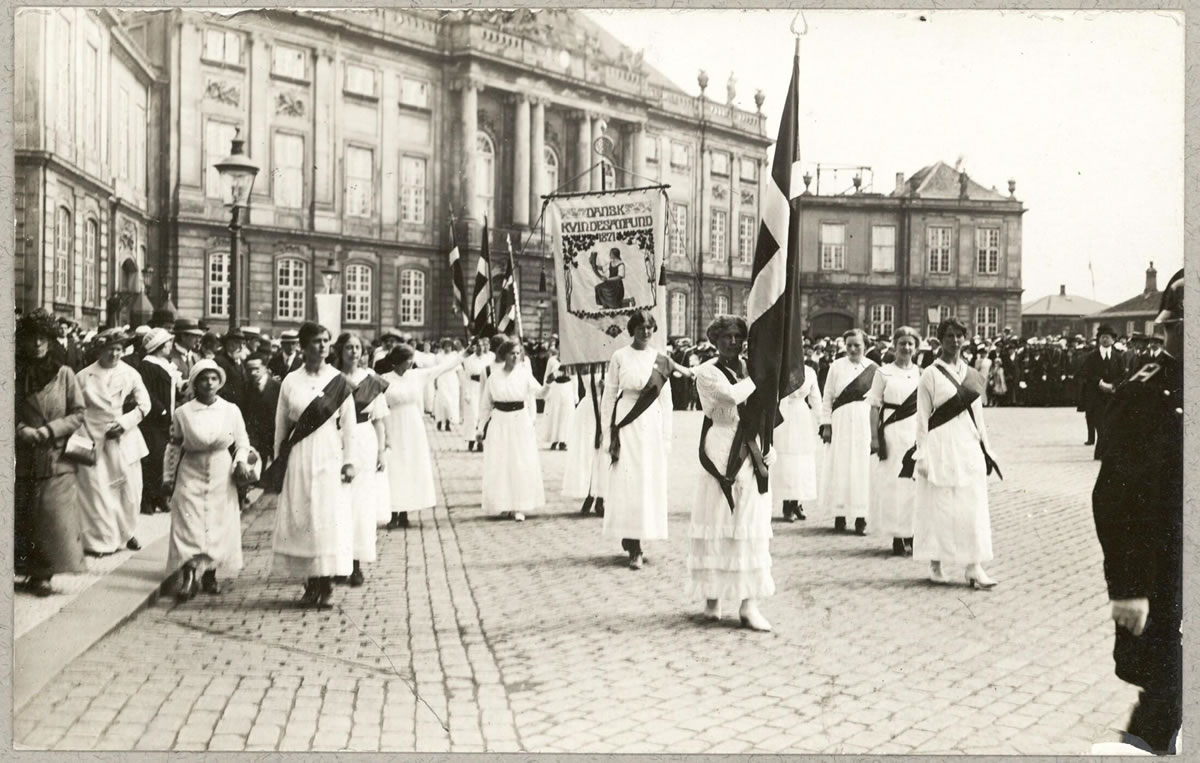
The Women’s Procession was arranged by more than 30 women’s organisations and attracted a great deal of attention in the streets of Copenhagen. The next day, the front pages of the newspapers all over the country were adorned with the vanguard of the Women’s Procession, which consisted of young women dressed in white carrying the flag of Dannebrog and the Danish Women’s Society’s banner. Photo: Ophav ukendt
Women’s Right to Vote in Denmark
Women’s Day Denmark / April 22, (1918)
DK
Denmark has a long history of promoting gender equality, and women’s right to vote in the country has been recognized for over a century. Denmark was one of the early adopters of women’s suffrage in Europe.
In 1915, Danish women achieved the right to vote and stand for election in municipal elections. This significant milestone marked the first time that women in Denmark had the opportunity to participate in the democratic process. However, it’s important to note that this right was initially limited to municipal elections.
In 1918, Denmark expanded women’s suffrage further, granting women the right to vote and stand for election in parliamentary elections as well. This move made Denmark one of the first countries in the world to grant women full suffrage on equal terms with men.
The women’s suffrage movement in Denmark played a crucial role in advocating for women’s rights and raising awareness about gender equality. Women’s organizations, activists, and reformers fought for equal political participation and successfully influenced legislative changes to ensure women’s right to vote.
Since gaining the right to vote, women in Denmark have actively participated in the democratic process. They have held various political positions, including members of parliament, government ministers, and even the country’s prime minister. Denmark has a strong tradition of promoting gender equality in politics, and women’s representation in decision-making positions has been relatively high compared to many other countries.
Efforts have been made to address gender disparities and further advance women’s political participation in Denmark. Gender equality initiatives, awareness campaigns, and policy measures have been implemented to encourage and support women’s leadership, improve gender balance in politics, and enhance women’s representation in both elected and appointed positions.
The women’s right to vote in Denmark represents a cornerstone of the country’s commitment to democracy and gender equality. It reflects the recognition of women as equal citizens and highlights the importance of their active participation in shaping the nation’s future. Denmark’s ongoing efforts to promote women’s political empowerment serve as an example for other countries striving for greater gender equality in politics.
100 years ago: Danish women voted for the first time at a parliamentary election
On 22 April 1918, Danish women went to the polling booths to cast their vote for the first time at a parliamentary election.
Due to World War I, women had to wait 3 years before they could use their newly won right to vote. 22 April 1918 became a special day in the history of the Danish democracy, when women for the first time were able to cast a vote.
> thedanishparliament.dk/1918-election
Women’s right to vote in Denmark / The Women’s Procession June 5, 1915
The struggle for the right to vote became a popular cause during the 1900s, and the victory in 1915 was marked by a demonstration procession through Copenhagen.
On the morning of 5 June 1915, Copenhagen was at sixes and sevens. The trams and streets were full of women who were on their way to take part in the women’s organisations’ arranged women’s procession to Amalienborg. The occasion was that the King would sign the new constitution that day, a constitution which made women democratic citizens. 10-12,000 – some newspapers even wrote 20,000 women – went through the city streets to mark that they now – after 30 years of struggle – had finally achieved the right to vote and could be elected to Parliament.
> kb.dk/political-citizenship
Women’s Entry into Politics: The Experience of the Danish Local and General Elections 1908-20
The article studies how enfranchised women reacted to the established political system. Should they seek to introduce new conflict dimensions or simply adjust to a party system, established before women gained the right to participate? In order to answer these questions, the aims and actions of the Danish women’s rights movement are investigated.
> tidsskrift.dk/scandinavian_political_studies/30003

